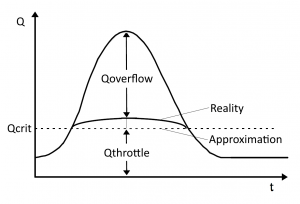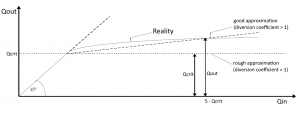Translations:Verzweigung/7/en: Unterschied zwischen den Versionen
Ferrao (Diskussion | Beiträge) (Die Seite wurde neu angelegt: „thumb|Discharge_division_by_Threshold_ConceptHere the second discharge is only activate…“) |
Keine Bearbeitungszusammenfassung |
||
| (Eine dazwischenliegende Version von einem anderen Benutzer wird nicht angezeigt) | |||
| Zeile 1: | Zeile 1: | ||
[[ | [[Datei:Abflussaufteilung_nach_Schwellwertkonzept_EN.png|thumb|Discharge distribution using a threshold value]] | ||
[[ | In this case the second outflow only becomes active if the inflow exceeds the threshold of <code>Qcrit</code>. In the threshold value approach, the 2nd outlet (e.g. stormwater overflow) is only activated once a critical inflow <code>Qcrit</code> is exceeded, causing the throttled outflow to back up, reaching the overflow threshold. Since in reality a perfect division of the outflows after reaching the threshold value is usually never achieved, a diversion coefficient can also be specified in order to better represent actual conditions. | ||
It is defined as: <math>\mbox{ | [[Datei:Trennschärfe_EN.png|thumb|Definition of the diversion coefficient in Talsim-NG]] | ||
It is defined as: <math>\mbox{diversion coefficient}= \frac{Q_{in}(Q_{out}=5 \cdot Q_{crit})}{Q_{crit}}</math> | |||
Aktuelle Version vom 26. November 2020, 10:37 Uhr
In this case the second outflow only becomes active if the inflow exceeds the threshold of Qcrit. In the threshold value approach, the 2nd outlet (e.g. stormwater overflow) is only activated once a critical inflow Qcrit is exceeded, causing the throttled outflow to back up, reaching the overflow threshold. Since in reality a perfect division of the outflows after reaching the threshold value is usually never achieved, a diversion coefficient can also be specified in order to better represent actual conditions.
It is defined as: [math]\displaystyle{ \mbox{diversion coefficient}= \frac{Q_{in}(Q_{out}=5 \cdot Q_{crit})}{Q_{crit}} }[/math]

